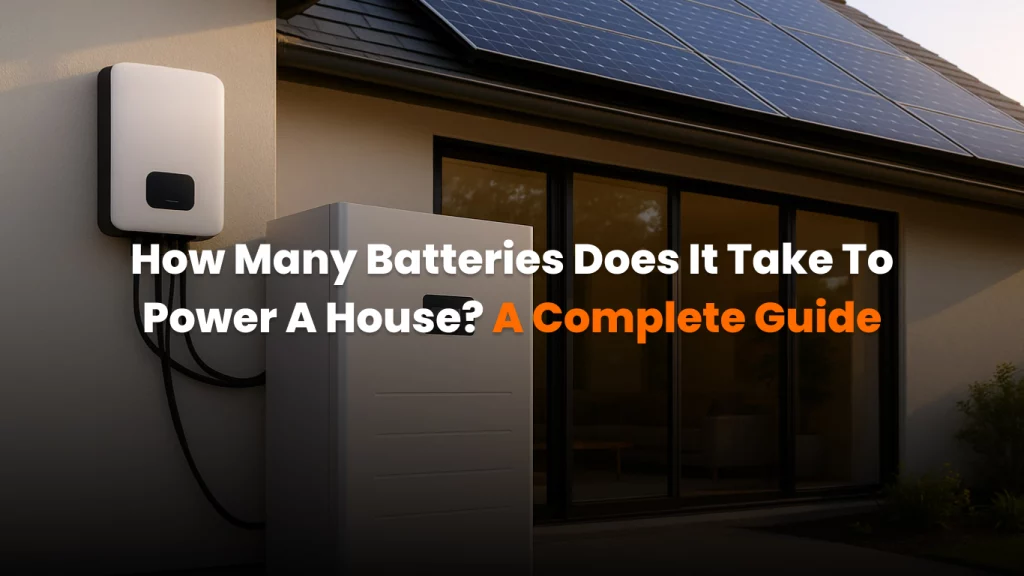As more homeowners turn to solar power and energy independence, one common question arises: how many batteries does it take to power an entire house? The answer isn’t as simple as a single number, because every household has different energy demands, habits, and appliances. However, by understanding how electricity is used, how batteries are rated, and how storage systems work, you can estimate the right setup for your home.
In this blog, we’ll break down the basics of energy usage, battery capacity, and how solar systems and battery storage can work together to keep your lights on, even when the grid goes down.
Understanding household energy consumption
The first step in figuring out how many batteries you need is knowing how much energy your home consumes daily. In the United States, the average household uses about 29–30 kilowatt-hours (kWh) of electricity per day, according to the U.S. Energy Information Administration (EIA).
However, this figure can vary dramatically:
- A small apartment might use only 10–15 kWh daily.
- A medium-sized suburban home typically uses 20–30 kWh daily.
- A large home with central air conditioning, electric heating, or an EV charger may use 50 kWh or more per day.
To estimate your own usage, review your monthly electricity bill. It usually shows total kWh used in a billing cycle. Divide that by 30 days, and you’ll know your daily average.
Battery capacity explained
When talking about home energy storage, battery capacity is measured in kilowatt-hours (kWh). This represents the total amount of energy the battery can store.
For example:
- Tesla Powerwall 3 (2025 version) stores about 13.5 kWh of usable energy.
- LG Chem RESU Prime stores around 16 kWh.
- Enphase IQ Battery 5P provides 5 kWh, but multiple units can be stacked together.
One important detail: most batteries don’t discharge 100% of their stored energy. Manufacturers typically set a limit (called the “depth of discharge”) to extend the lifespan of the unit. So if a battery is rated for 10 kWh, you may only be able to use 8–9 kWh at a time.
How many batteries do you really need?
Let’s put the math into perspective with a typical American home using 30 kWh per day:
- With one Tesla Powerwall (13.5 kWh), you would cover less than half a day’s usage.
- Two Powerwalls would provide about 27 kWh, nearly enough for one day.
- Three Powerwalls would comfortably cover daily usage, with some extra capacity for cloudy days or higher demand.
If you want full off-grid living with several days of backup, you’d likely need 5–7 large batteries, depending on your energy needs and how conservative you are with power.
Do you need to power your whole house?
Not every homeowner installs enough battery storage to cover the entire home. Many choose to back up only essential loads, such as:
- Refrigerator and freezer
- Lights and outlets in main living areas
- Wi-Fi and communication devices
- Medical equipment
- Sump pump or well pump
- Heating or cooling systems (depending on climate)
By focusing on essentials, you might only need 1–2 batteries, rather than an entire bank capable of running everything at once.
Solar panels and batteries: a perfect pair
Batteries alone don’t generate power, they only store it. That’s why most people pair them with solar panels. Solar panels charge your batteries during the day, and you can draw from them at night or during outages.
A solar + storage system allows you to:
- Reduce reliance on the grid.
- Store excess solar energy that would otherwise go unused.
- Protect against blackouts.
- Save money if your utility offers time-of-use rates (charging batteries with cheap solar power, then using them when grid rates are high).
Grid-tied vs. off-grid setups
There are two main ways homeowners use battery storage:
- Grid-tied with backup – Your home is connected to the utility grid, but batteries kick in during outages or when solar production is low. This is the most common setup in the U.S.
- Off-grid – Your home is fully independent of the grid. This requires a larger battery bank and more panels, since you’re your own power provider 24/7. While possible, it’s more expensive and usually only pursued by rural homeowners or those seeking complete energy independence.
Cost considerations in 2025
The cost of residential batteries has dropped steadily over the past decade, but they’re still a major investment. In 2025:
- A single Tesla Powerwall 3 costs about $9,000–$10,500 installed.
- Enphase and LG Chem batteries range from $6,000–$12,000, depending on size and installation.
Most homes that want whole-home backup spend between $20,000–$40,000 for a full battery storage system, often paired with a solar installation. Federal tax credits, state rebates, and utility incentives can reduce the final price.
How long do batteries last?
Most modern lithium-ion home batteries are warrantied for 10 years or about 6,000 charge cycles. In practice, this means they’ll retain around 70–80% of their original capacity after a decade. Proper maintenance, climate control, and software updates can extend their usable life.
Is battery storage right for you?
Battery storage isn’t necessary for every homeowner. If you live in an area with reliable grid power and low utility rates, the payback period may be long. But if you want backup protection, energy independence, or live in a region with frequent outages (like California, Texas, or Florida), batteries can be a game-changer.
Final thoughts
So, how many batteries does it take to power a house? The answer depends on your energy use, your goals, and whether you want full independence or just peace of mind during blackouts. For the average American household, 2–3 large-capacity batteries paired with solar panels are enough for daily needs, while going completely off-grid could require 5 or more.
As technology improves and costs continue to fall, battery storage is becoming one of the most practical ways for homeowners to take control of their energy future. Whether you’re looking to cut utility bills, keep the lights on during storms, or move closer to energy independence, batteries can make solar power even more powerful.




